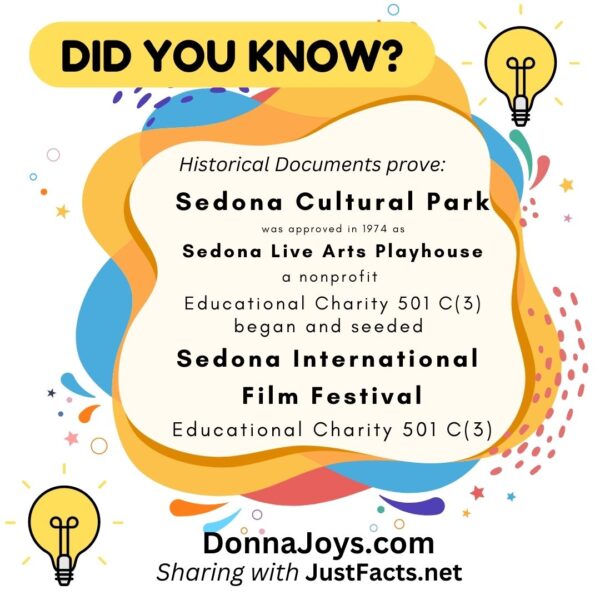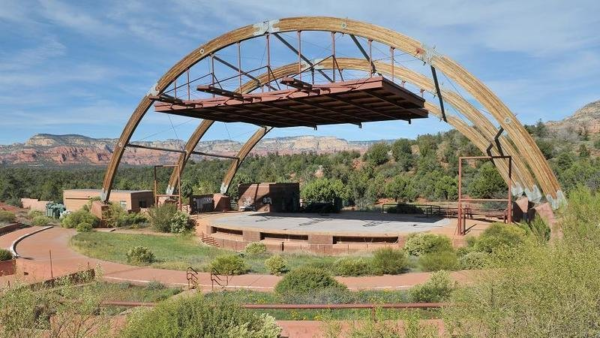Sedona Cultural Park
Historical Research Credit-
Donna Joy Varney has conducted a deep dive into the historical documents of the Sedona Cultural Park. Donna Joy’s files have the full collection of documents including land Patents, Forest Land Exchange, BLM, and supporting documents. Visit DonnaJoys.com
Eddie Maddock gracefully allowed Donna to copy her files on Sedona Cultural Park.
Protect & preserve our promised community asset, the Sedona Cultural Park.
Sedona Citizens Invested $9,000,000.00 in donations into the Sedona Cultural Park.
Citizens donated more money for this land than the current owner paid for it. Mike Tennyson should donate the Land back to the community for the public good as he originally stated he was so happy for Sedona to have a Cultural Park on 12/09/2003.
SEDONA
SEDONA ARIZONA CULTURAL CENTER AMPHITHEATER-ABANDONED AND BANKRUPT-EP42
By Our Journey In Myles YouTube Channel
The Sedona Cultural Park is in ruins. It has been mismanaged for over twenty years.
Red Rock Amphitheatre
Red Rocks Amphitheatre is owned and successfully operated by the City of Denver and County of Denver. Red Rocks Amphitheatre

Red Rocks is owned and operated by the City and County of Denver;

Red Rock Amphitheatre is owned and operated by the City and County of Denver;
Quotes on Sedona Cultural Park:
“The road access into trailhead and the National Forest beyond is a reservation in the land exchange patent”
Heather C. Provencio
USDA District Ranger
“Not withstanding our filing with the City our priority is still to see the Park remain as a public asset to Sedona ”
Mike Tennyson
Developer, Sathcupa
“That request is not supported by the current community plan provisions as comprehensively evaluated and discussed in the November 18, 2003 staff report.“
Councilor Nahmanson
Member City Council, City of Sedona
“The request does not constitute an improvement to the Sedona Community Plan.”
Sedona City Council
City of Sedona
“Support the recommendations of the Environmental Assessment of
the 1998 revised USES Plan which would not allow for disposal of
National Forest lands within or adjacent to the City except for the
Chapel site and USFS headquarters.”
City of Sedona
Community Plan
“A Major Amendment to the community plan is required in this case, because the existing zoning on the subject property does not currently permit what is being
requested, and because changing the zoning to permit the request would not be consistent with our existing community plan.”
Mike Raber
Associate Planner
City of Sedona
FINANCE RECORDS
Sedona Cultural Park finance records Review here
Revenues
2002 – 2.5 Million
2003 – 1.9 million
BACKGROUND
The Sedona Cultural Park was the property of the United States National Forest.
It was part of the Hopi Footprints Migration Area, sacred land to the Apache, and was also an Indian Reservation.
In 1993, the Sedona Cultural Park land was designated as “Open Space Preservation/Conservation” on the Sedona Community Plan Land Use Map.
In 1993, the Sedona Land Use Map was amended to “Public/Semi-public” to benefit the community of Sedona and the Sedona Cultural Park to accommodate the community cultural facilities and amenities.
Note: At that time in 1993, the Sedona Community Plan only supported USFS land trades for public/semi-public uses, open spaces, or parks. Land use Sedona Community Plan 1998
Subsequent to the Community Plan amendment, the land trade was facilitated and completed.
The 50.31 acres of USFS land now known as the Sedona Cultural Park was traded for 724 acres of Arizona real estate, sold, and directly transferred from the USFS to the Sedona Cultural Park, Inc. non-profit on July 10, 1996 for 1.6 million dollars.. This land exchange encompassed 71 acres originally but the USFS took back 20 acres because the land had too many Native American Artifacts and was designated as a Heritage Site.
In 1995 the city of Sedona rezoned the Sedona Cultural Park property to Planned Development. The rezoning allowed the proposed uses for the Sedona Cultural Park to benefit the public, including an outdoor amphitheater, festival grounds parking. Plans included an Arts Village, Performing Arts Center, and exhibition buildings. In 1997 and 2001, the Park sold 6 acres of land to Yavapai College. Land use restrictions were attached to the sale; see the Deed with the Land Use Restrictions here.
The Sedona Cultural Park had its grand opening in May of 2000. On the opening night Dilzhe’e Apache Elder Vincent Randall, Historian, former Yavapai-Apache Chairman, and Manager of the Apache Cultural Resource Center. The Sedona Cultural Park was owned and operated by Sedona Cultural Park, Inc. 501(c)3, an Arizona non-profit managed by their board of directors.
To this day the USFS refuses to disclose under the Freedom of Information Act to the public any information about the Heritage Sites or the artifacts that were found. Despite the fact that land in private hands is no longer protected from FOIA requests.
What Mike Tennyson Bought
50.31 acres of land dedicated to public use for the benefit of the community, containing a right of way for an existing access road to the Girdner Mineral Pit, said easement is 66 feet wide and encompasses 1.336 acres of land. Plus public access to trailheads.
The City of Sedona was awarded two Heritage Fund Grants in the amounts of received $586,000 and $444,200 completed on June 5, 2000 from the State of Arizona to further develop the Sedona Cultural Park.
THE COMMUNITY PROMISE
During the lengthy land exchange several promises were made. The board of directors negotiated an agreement, “Sedona Cultural Park Contract With Sedona” of July 25, 1995 , This promised and pledge was printed in the Sedona Red Rock News.
In the Decision Notice the Sedona Cultural Park proposed Master Plan the development of the land would be under the guidance of the City of Sedona’ s Planning and Development process.
THE VOTE OF THE PEOPLE
Proposition 400 during General Election May 21, 1996. The Voters voted for the Sedona Cultural Park.
COMMUNITY INVESTMENT
Thousands and thousands of hours of dedicated and devoted labor and $14,000,000. million dollars were invested in the Sedona Cultural Park prior to it being sold. A $5 million investment was debt and $9 million was gifted as donations from residents in the Sedona area.
This has all been lost in the sale of the park, along with the park itself.
Detailed promises were made to save the park by Michael Tennyson but none of those promises manifested.
BOUGHT AS A CULTURAL PARK
The Sedona Cultural Park was purchased at a price lower than the Sedona Cultural Park assets recorded in financial records as a Cultural Park. The Sedona Cultural Park was removed from receivership and sold privately to Tennyson and partners a LLC. The buyer was involved with the SCP and fully knew of the restrictions and zoning of the property. RESTRICTIONS were also imposed on Yavapai College by Tennyson with a first right to buy the property back from the college.
REZONING attempts.
The current owner has made attempts to rezone the property. The City of Sedona denied previous requests for rezoning. A request for zoning change 2003 fo a Hotel and in 2006 denied request to rezone the property to residential.
USDA ACCESS
Public access to the trailhead.
Public access to recreational facilities.
Future development also cannot preclude access on Cultural Park Place to the USFS mineral pit to the north.
CURRENT ZONING – USE MAP
The Sedona Cultural Park is zoned for a Cultural Park, Public/Semi-Public

Community Expectations
- *Provide a center for education, research, arts, and events. Land use options should remain flexible to further these interests.
- *Coordinate objectives between property owners, Yavapai College, and the Sedona Red Rock High School for educational programs.
- *Maintain access to National Forest trails.
- *Preserve natural open space on ridgelines and along highway.
- *Provide visitor information and promote as a Sedona gateway with parking facilities that could also be linked to transit.
- *Provide main highway access via Cultural Park Place and Upper Red Rock Loop Road.
REFERENCE DOCUMENTS
page-21-Western-gateway-2017-land-useDownload
12-09-2003 (R) 1-79 pages Sedona City Council(1) (1)Download
Sedona Community Plan 1998 R98-3203Download
The original land exchange was for 70 acres as shown in this Warranty Deed document. It was reduced to 50 acres. It has been indicated that the reduction of 28.57% or 20 acres may have to do with the heritage sites in the area.
Donna Joy has
- Forest Land Exchange
- Loan records
- County records
- Bureau of Land Management documents
- court & other records
- City minutes
Sedona Cultural Park Posts & Pages
Pages
Sedona Cultural Park Documented History Trail
Sedona Cultural Park Forest Land
Posts
Sedona Fact Finds: Sedona Cultural Park & SIFF
What does the Sedona Cultural Park & Sedona International Film Festival have in common? Research and historical documents show us that the Sedona Cultural Park…
Continue Reading Sedona Fact Finds: Sedona Cultural Park & SIFF
Sedona Cultural Park Inc. Background
Sometimes things get lost in time and the story changes. After years of hearing many different stories, I deeply studied the historical data-driven documents on…
Recipes | Culinary Art Galleries | Community Projects
tips ~ ideas ~ inspiration ~ research
Donna Joy ~ A retired Entrepeneur, Creator, Business owner, Culinary Artist, Chef & Chief Operating Disruptor.
♥ Donna Joy




